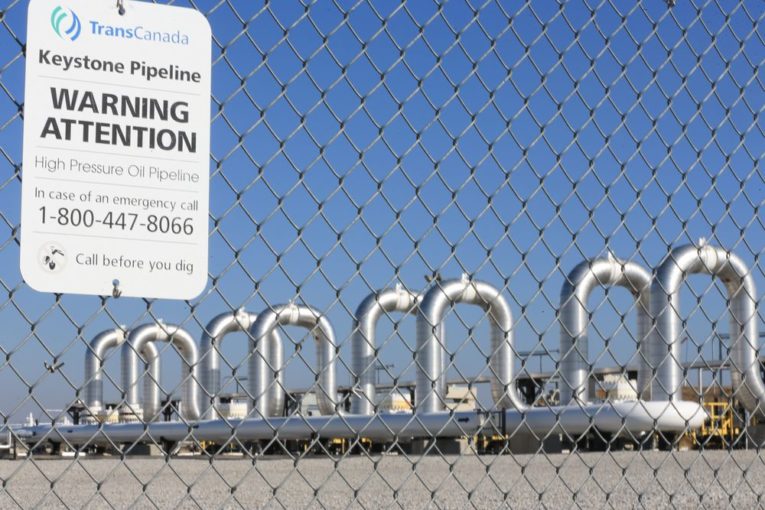
CALGARY – Enbridge Inc., Canada’s largest pipeline operator, warned its network of oil pipelines is reaching maximum capacity, on the day heavy oil prices collapsed after pipeline companies started rationing space to oil producers amid surging Western Canadian supplies.
The Western Canada Select heavy oil benchmark dropped sharply Tuesday from more than US$36 per barrel as trading opened, to US$30.64 per barrel mid-day, leading to the widest discount Canadian oil producers have seen in three years compared with the U.S. benchmark West Texas Intermediate.
During an investor day presentation Tuesday, Guy Jarvis, Enbridge executive vice-president, liquids pipelines and major projects, said his company’s oil pipeline network is reaching maximum capacity and would remain full even if competing oil pipelines were built in the near term. In a slide titled Enbridge System Likely to be at Maximum Capacity, the company said its system is expected to be at or near capacity through 2021.
“Under the ‘one pipeline scenario,’ the outlook for the (Enbridge) mainline is to remain chock full even under the lowest production outlook,” Jarvis said.
Jarvis told financial analysts Tuesday that he believed Enbridge’s Line 3 replacement project would be the first of three proposed oil pipeline projects (the other two being TransCanada’s Keystone XL and Kinder Morgan Canada’s Trans Mountain expansion) to be in service.
Line 3 would restore 375,000 bpd of pipeline capacity between Alberta and Superior, Wisc. The project is still awaiting regulatory approvals in Minnesota but Jarvis said work is nearly complete in Wisconsin and Canada.
Even in a scenario in which two competing oil pipelines are built, Jarvis said Enbridge does not expect volumes on its network to be “materially affected” because there is so much additional oil production forecast for the coming years.
Western Canadian oil production hit 4.16 million barrels per day by November, compared with 4.05 million bpd at the start of the year, according to the National Energy Board, forcing pipeline operators such as Enbridge to apportion barrels on their systems. In response, many oil companies have moved a large amount of crude into storage tanks in Edmonton and Hardisty, Alta. and are also utilizing rail cars to export their barrels.
These developments have led to a doubling of the discount that Canadian producers must accept for their barrels, as they miss out on the oil price rally. WTI prices have risen steadily over the past six months; the benchmark traded at US$57.16 per barrel Tuesday, while Brent crude prices also briefly surged to US$65 on fears of a pipeline disruption in the North Sea.
The discount between the two North American benchmark prices would remain wide over the next several years and average between US$13 and US$18 per barrel, after the discount was smaller at US$11 to US$12 per barrel earlier this year, according to Fitch Ratings.
The credit ratings agency said in a note Tuesday that the wider discount was a result of “the current lack of pipeline capacity out of Canada in the face of growing oilsands production and, after 2020, the phase out of high-sulfur fuel oil as a marine fuel, which is also expected to weigh on the WCS discount.”
The lack of available pipeline capacity came into sharp focus last month, when TransCanada Corp. shut down its Keystone pipeline system between Alberta and the U.S. Gulf Coast after a leak in South Dakota. The line is shipping oil again, but at reduced volumes.
“What that did is accelerate an issue that was going to happen in 2018,” Genscape crude oil analyst Mike Walls said, adding the widening in differentials between WCS and WTI had been forecast but the Keystone issue has moved the timing forward.
“These are the widest differentials we’ve seen in three years,” he said.
Walls said oil producers reacted by moving barrels into storage tanks in Alberta, leading to “larger than normal builds in Western Canada.” Oil companies also scrambled to find oil-by-rail cars to move their barrels to the U.S.
“The outage came totally unexpected,” GMP FirstEnergy analyst Martin King said of the Keystone spill, adding that many producers were not able to immediately send more of their barrels to market on railway cars because “you need more time to arrange all the logistics.”
King said there are oil-by-rail loading facilities in Western Canada capable of moving 700,000 bpd out of the market and producers are making arrangements to ship more oil out of the province that way.
When TransCanada’s Keystone system resumes shipping at full volumes, King said he expects differentials between WCS and WTI would shrink by US$5 to US$6 per barrel.
You can read more of the news on source
